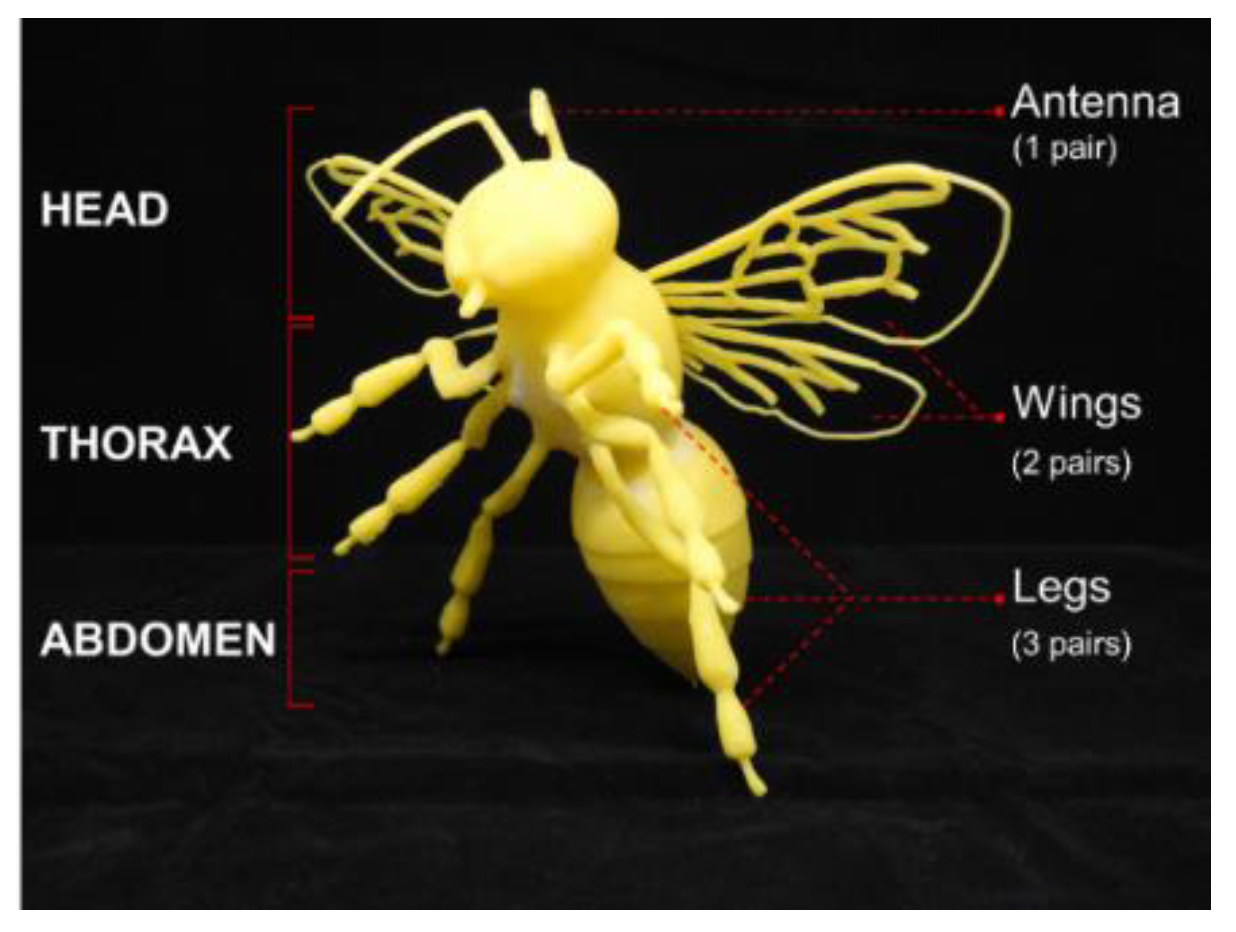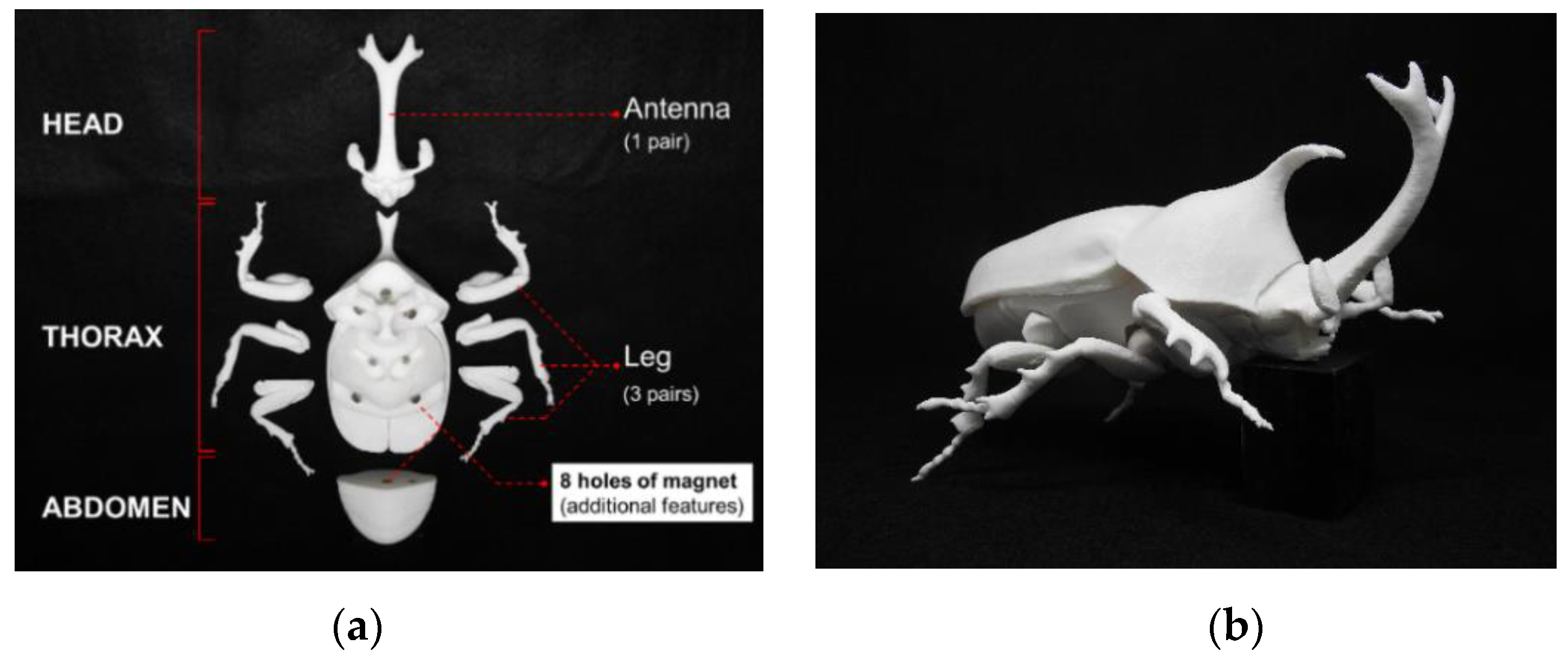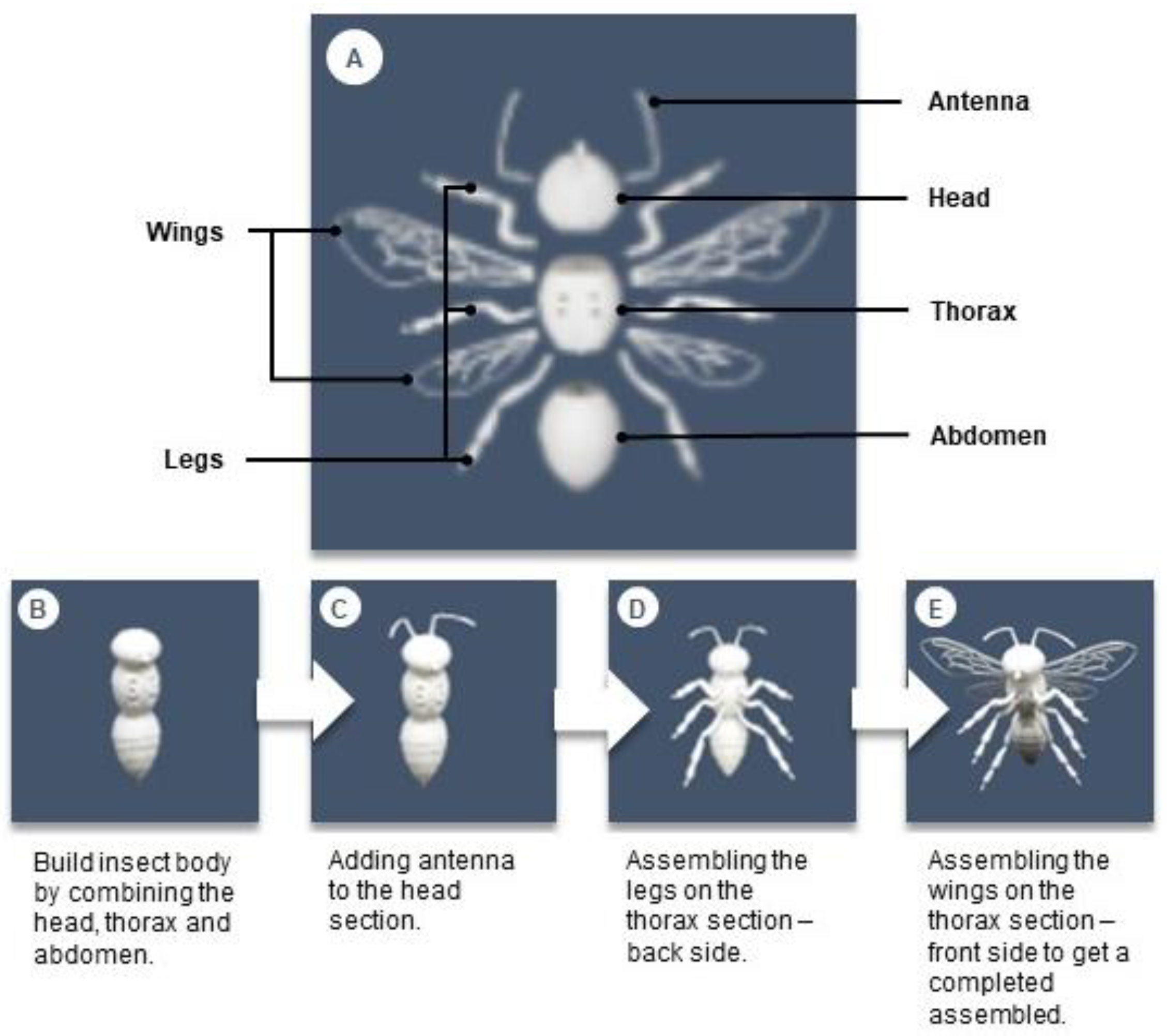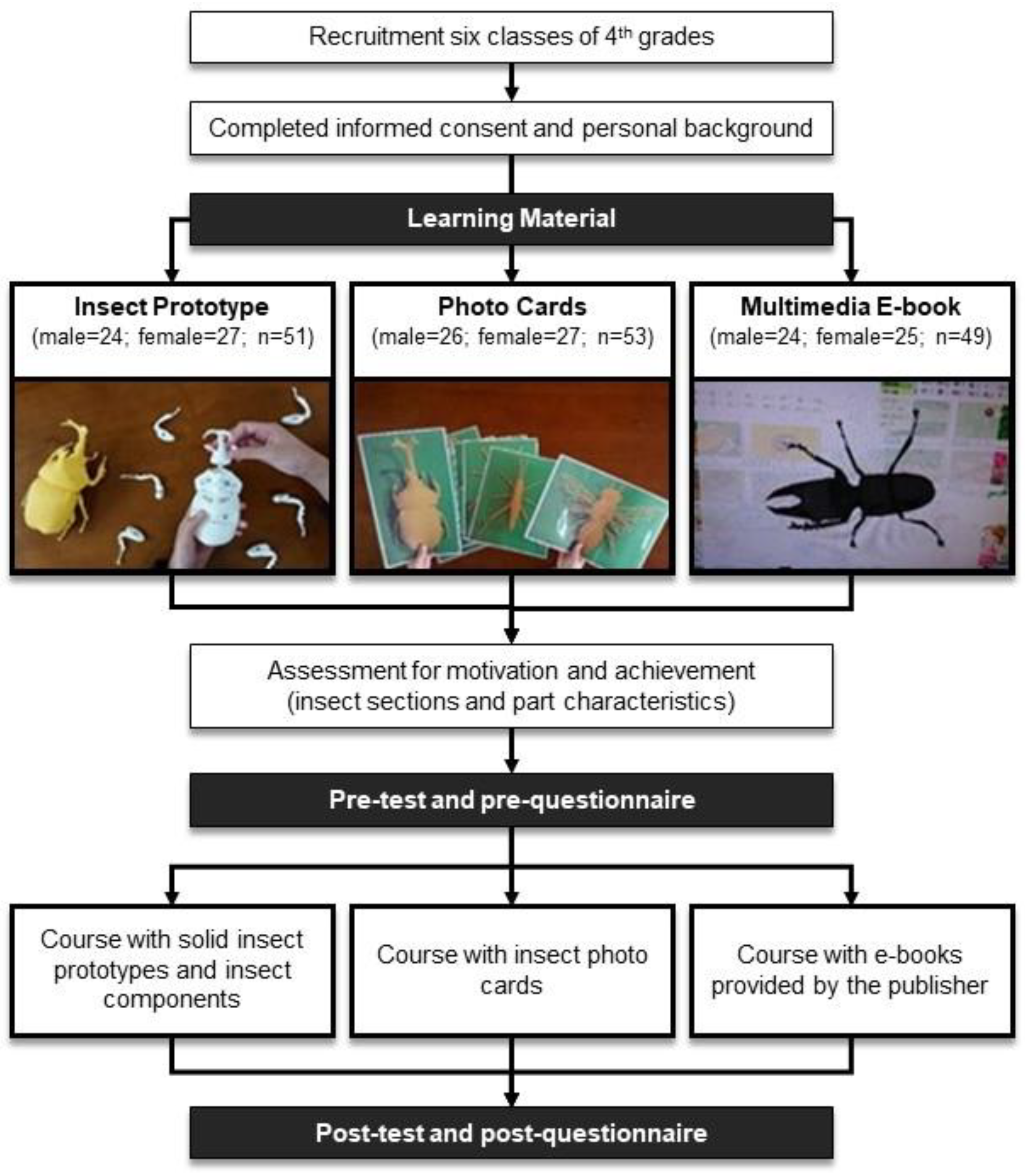The Role of Digital-Media-Based Pedagogical Aids in Elementary Entomology: An Innovative and Sustainable Approach
Abstract
:1. Introduction
2. Materials and Methods
2.1. Stimuli Development
2.1.1. Insect Prototype
2.1.2. Photo Card
2.1.3. Multimedia E-Book
2.2. Procedure
2.3. Measures & Analysis
3. Results
3.1. Three Group Learning Knowledge and Motivation
3.2. Pre-Post Comparison Learning Knowledge and Motivation
3.3. Learners Perception
4. Discussion
4.1. Elementary Entomology Using 3DP
4.1.1. Knowledge
4.1.2. Motivation
4.1.3. Subjective Opinion
4.2. The Role of Digital Media-Based 3DP Application in Learning
4.3. Further Exploration on Digital Media-Based 3DP Application in Learning
5. Conclusions
Author Contributions
Funding
Acknowledgments
Conflicts of Interest
Appendix A
Appendix B
| Item | Question |
| Attention (ATTEN) | |
| ATTEN1 | The teaching method of this course is interesting and attractive to me. |
| ATTEN2 | The content of this course will be/were interesting throughout. |
| ATTEN2 | The way this course is explained helps me focus |
| ATTEN3 | The content of this course is not clear and specific enough, making it difficult for me to concentrate |
| ATTEN4 | The way the course content is presented in the teaching aids helps me focus |
| ATTEN5 | I am deeply impressed by the teaching aids in this course. |
| ATTEN6 | The presentation of the teaching aids in this course, the method of explanation, and the various exercises can help me concentrate. |
| Relevance (REV) | |
| REV1 | From the introduction in the first part of the class, I will know what I will learn/knew what I would learn about in the remainder of the course. |
| REV2 | The content of this course is relevant to the knowledge I have learned before. |
| REV3 | It is very important for me to study the content of this course. |
| REV4 | This course is related to or in line with my usual interest. |
| REV5 | I will know/know how to apply what I will learn/learned in the course. |
| REV6 | I will learn/learned something from this course that I didn’t expect to learn. |
| REV7 | I can connect the content of this course with things I have learned or done and thought about before. |
| Confidence (COF) | |
| COF1 | The content of this course is just right for me, neither too difficult nor too easy. |
| COF2 | When I am studying this course, I am confident that I can learn it well. |
| COF3 | This course will be/was too difficult for me. |
| COF4 | There are a lot of repetitive parts in this course that make me feel very tired. |
| COF5 | After studying this course, I think I can answer the exam questions related to the course. |
| COF6 | I don’t think I need to take this course because I already know its content. |
| COF7 | Because the content of this course is very organized, I have the confidence to learn it well. |
| Satisfaction (SAT) | |
| SAT1 | After learning all the content of this course, I will feel/felt very rewarded. |
| SAT2 | I like this course very much, and I hope to have the opportunity to learn more about it. |
| SAT3 | I will enjoy/enjoyed this course very much. |
| SAT4 | The content of this course and the way it is explained make me feel that it is worth learning. |
| SAT5 | In this course, the teacher can give me positive encouragement in a timely manner. |
| SAT6 | After finishing this course, I feel/felt very fulfilled. |
| SAT7 | I am very happy to have the opportunity to study this course. |
- What do children think the most fun part of this course? Please describe it in words.
- What new things do you think to be more interesting for the children? Please describe it in words.
References
- Duffus, N.E.; Christie, C.R.; Morimoto, J. Insect cultural services: How insects have changed our lives and how can we do better for them. Insects 2021, 12, 377. [Google Scholar] [CrossRef] [PubMed]
- Sammet, R.; Dreesmann, D. What do secondary students really learn during investigations with living animals? Parameters for effective learning with social insects. J. Biol. Educ. 2017, 51, 26–43. [Google Scholar] [CrossRef]
- Shipley, N.J.; Bixler, R.D. Beautiful bugs, bothersome bugs, and FUN bugs: Examining human interactions with insects and other arthropods. Anthrozoos 2017, 30, 357–372. [Google Scholar] [CrossRef]
- Shepardson, D.P. Bugs, butterflies, and spiders: Children’s understandings about insects. Int. J. Sci. Educ. 2002, 24, 627–643. [Google Scholar] [CrossRef]
- Forister, M.L.; Pelton, E.M.; Black, S.H. Declines in insect abundance and diversity: We know enough to act now. Conserv. Sci. Pract. 2019, 1, e80. [Google Scholar] [CrossRef]
- Didham, R.K.; Basset, Y.; Collins, C.M.; Leather, S.R.; Littlewood, N.A.; Menz, M.H.M.; Müller, J.; Packer, L.; Saunders, M.E.; Schönrogge, K.; et al. Interpreting insect declines: Seven challenges and a way forward. Insect Conserv. Divers. 2020, 13, 103–114. [Google Scholar] [CrossRef]
- Novak, E.; Wisdom, S. Effects of 3D printing project-based learning on preservice elementary teachers’ science attitudes, science content knowledge, and anxiety about teaching science. J. Sci. Educ. Technol. 2018, 27, 412–432. [Google Scholar] [CrossRef]
- Sullivan, P.; McCartney, H. Integrating 3D printing into an early childhood teacher preparation course: Reflections on practice. J. Early Child Teach Educ. 2017, 38, 39–51. [Google Scholar] [CrossRef]
- Emmons, N.; Smith, H.; Kelemen, D. Changing minds with the story of adaptation: Strategies for teaching young children about natural selection. Early Educ. Dev. 2016, 27, 1205–1221. [Google Scholar] [CrossRef]
- Serafini, F.; Kachorsky, D.; Aguilera, E. Picture books in the digital age. Read. Teach. 2016, 69, 509–512. [Google Scholar] [CrossRef]
- Abdulhameed, O.; Al-Ahmari, A.; Ameen, W.; Mian, S.H. Additive manufacturing challenges, trends, and applications. Adv. Mech. Eng. 2019, 11, 1687814018822880. [Google Scholar] [CrossRef]
- Gardan, J. Additive manufacturing technologies: State of the art and trends. Int. J. Prod. Res. 2015, 54, 3118–3132. [Google Scholar] [CrossRef]
- Snyder, T.J.; Andrews, M.; Weislogel, M.; Moeck, P.; Stone-Sundberg, J.; Birkes, D.; Hoffert, M.P.; Lindeman, A.; Morrill, J.; Fercak, O.; et al. 3D systems’ technology overview and new applications in manufacturing, engineering, science, and education. 3D Print. Addit. Manuf. 2014, 1, 169–176. [Google Scholar] [CrossRef] [PubMed]
- AbouHashem, Y.; Dayal, M.; Savanah, S.; Štrkalj, G. The application of 3D printing in anatomy education. Med. Educ. Online 2015, 20, 29847. [Google Scholar] [CrossRef]
- Keaveney, S.; Keogh, C.; Gutierrez-Heredia, L.; Reynaud, E.G. Applications for advanced 3D imaging, modelling, and printing techniques for the biological sciences. In Proceedings of the 22nd International Conference on Virtual System & Multimedia (VSMM), Kuala Lumpur, Malaysia, 17–21 October 2016; pp. 1–8. [Google Scholar]
- Ford, S.; Minshall, T. Invited review article: Where and how 3D printing is used in teaching and education. Addit. Manuf. 2019, 25, 131–150. [Google Scholar] [CrossRef]
- Bogacka, M.; Salazar, G.L. Study on the Effect of Bio-Based Materials’ Natural Degradation in the Environment. Sustainability 2022, 14, 4675. [Google Scholar] [CrossRef]
- Ferreira, E.d.S.B.; Luna, C.B.B.; Siqueira, D.D.; dos Santos Filho, E.A.; Araújo, E.M.; Wellen, R.M.R. Production of Eco-Sustainable Materials: Compatibilizing Action in Poly (Lactic Acid)/High-Density Biopolyethylene Bioblends. Sustainability 2021, 13, 12157. [Google Scholar] [CrossRef]
- Corum, K.; Garofalo, J. Using digital fabrication to support student learning. 3D Print. Addit. Manuf. 2015, 2, 50–55. [Google Scholar] [CrossRef]
- Costello, J.P.; Olivieri, L.J.; Krieger, A.; Thabit, O.; Marshall, M.B.; Yoo, S.-J.; Kim, P.C.; Jonas, R.A.; Nath, D.S. Utilizing three-dimensional printing technology to assess the feasibility of high-fidelity synthetic ventricular septal defect models for simulation in medical education. World J. Pediatr. Congenit. Heart Surg. 2014, 5, 421–426. [Google Scholar] [CrossRef] [PubMed]
- Short, D.B. Use of 3D printing by museums: Educational exhibits, artifact education, and artifact restoration. 3D Print Addit. Manuf. 2015, 2, 209–215. [Google Scholar] [CrossRef]
- Xue, Q.; Sánchez-Monge, G.; Bert, W. Three-dimensional modelling and printing as tools to enhance education and research in Nematology. Nematology 2015, 17, 1245–1248. [Google Scholar]
- Trust, T.; Maloy, R.W. Why 3D print? The 21st-century skills students develop while engaging in 3d printing projects. Comput. Sch. 2017, 34, 253–266. [Google Scholar] [CrossRef]
- Wisdom, S.; Novak, E. Using 3D printing to enhance STEM teaching and learning: Recommendations for designing 3D printing projects. In Integrating 3D Printing into Teaching and Learning; Brill: Leiden, The Netherlands, 2019; pp. 187–205. [Google Scholar]
- Garcia, J.; Yang, Z.; Mongrain, R.; Leask, R.L.; Lachapelle, K. 3D printing materials and their use in medical education: A review of current technology and trends for the future. BMJ STEL 2018, 4, 27–40. [Google Scholar] [CrossRef] [PubMed]
- Ma, L.; Lee, C.S. Evaluating the effectiveness of blended learning using the ARCS model. J. Comput. Assist. Learn. 2021, 37, 1397–1408. [Google Scholar] [CrossRef]
- Creswell, J.W.; Creswell, J.D. Research Design: Qualitative, Quantitative, and Mixed Methods Approaches; Sage Publication: Los Angeles, CA, USA, 2017. [Google Scholar]
- Fives, H.; Barnes, N. Classroom test construction: The power of a table of specifications. Pract. Assess. Res. Eval. 2013, 18, 3. [Google Scholar]
- Keller, M.J. Motivational Design for Learning and Performance: The ARCS Model Approach; Springer Science: London, UK, 2010. [Google Scholar]
- McMenamin, P.G.; Quayle, M.R.; McHenry, C.R.; Adams, J.W. The production of anatomical teaching resources using three-dimensional (3D) printing technology. Anat. Sci. Educ. 2014, 7, 479–486. [Google Scholar] [CrossRef] [PubMed]
- Somyurek, S. An effective educational tool: Construction kits for fun and meaningful learning. Int. J. Technol. Des. Educ. 2015, 25, 25–41. [Google Scholar] [CrossRef]
- Cinici, A. From caterpillar to butterfly: A window for looking into students’ ideas about life cycle and life forms of insects. J. Biol. Educ. 2013, 47, 84–95. [Google Scholar] [CrossRef]
- Leach, J.; Driver, R.; Scott, P.; Colin, W.R. Progression in Understanding of Ecological Concepts by Pupils Aged 5 to 16; The University of Leeds, Centre for Studies in Science and Mathematic Education: West Yorkshire, UK, 1992. [Google Scholar]
- Penny, M.R.; Cao, Z.J.; Patel, B.; dos Santos, B.S.; Asquith, C.R.M.; Szulc, B.R.; Rao, Z.X.; Muwaffak, Z.; Malkinson, J.P.; Hilton, S.T.; et al. Three-dimensional printing of a scalable molecular model and orbital kit for organic chemistry teaching and learning. J. Chem. Educ. 2017, 94, 1265–1271. [Google Scholar] [CrossRef]
- Galbis-Córdoba, A.; Martí-Parreño, J.; Currás-Pérez, R. Education students’ attitude towards the use of gamification for competencies development. J. e-Learn. Knowl. Soc. 2017, 13, 1. [Google Scholar]
- Aral, N.; Gursoy, F.; Yasar, M.C. An investigation of the effect of puzzle design on children’s development areas. Procedia-Soc. Behav. Sci. 2012, 51, 228–233. [Google Scholar] [CrossRef]
- Tudor, J.; Penlington, R.; McDowell, L. Perceptions and their influences on approaches to learning. J. Eng. Educ. 2010, 5, 69–79. [Google Scholar] [CrossRef]
- Prokop, P.; Fancovicova, J. The effect of hands-on activities on children’s knowledge and disgust for animals. J. Biol. Educ. 2017, 51, 305–314. [Google Scholar] [CrossRef]
- Piaget, J. Piaget’s Theory. In Piaget and His School; Springer: Berlin/Heidelberg, Germany, 1976; pp. 11–23. [Google Scholar]
- Moeck, P.; Stone-Sundberg, J.; Snyder, T.J.; Kaminsky, W. Enlivening 300 level general education classes on nanoscience and nanotechnology with 3D printed crystallographic models. J. Mater. Educ. 2014, 36, 77–96. [Google Scholar]
- Szymanski, A. Prototype problem solving activities increasing creative learning opportunities using computer modeling and 3D printing. In Creativity and Technology in Mathematics Education; Springer: Cham, Switzerland, 2018; pp. 323–344. [Google Scholar]
- Jandova, S.; Mendricky, R. Benefits of 3D printed and customized anatomical footwear insoles for plantar pressure. 3D Print. Addit. Manuf. 2021; ahead of print. [Google Scholar]
- Eisenberg, M. 3D printing for children: What to build next? Int. J. Child-Comput. Interact. 2013, 1, 7–13. [Google Scholar] [CrossRef]
- Liu, Y.C.; Lu, S.J.; Kao, C.Y.; Chung, L.; Tan, K. Comparison of AR and physical experiential learning environment in supporting product innovation. Int. J. Eng. Bus. Manag. 2019, 11, 1–10. [Google Scholar] [CrossRef]
- Griffith, K.M.; Cataldo, R.D.; Fogarty, K.H. Do-It-Yourself: 3D models of hydrogenic orbitals through 3d printing. J. Chem. Educ. 2016, 93, 1586–1590. [Google Scholar] [CrossRef]
- Su, C.H.; Cheng, C.H. A mobile game-based insect learning system for improving the learning achievements. Procedia Soc. Behav. Sci. 2013, 103, 42–50. [Google Scholar] [CrossRef]
- Tarng, W.; Ou, K.L.; Yu, C.S.; Liou, F.L.; Liou, H.H. Development of a virtual butterfly ecological system based on augmented reality and mobile learning technologies. Virtual Real. 2015, 19, 253–266. [Google Scholar] [CrossRef]
- Lu, S.J.; Liu, Y.C.; Chen, P.J.; Hsieh, M.R. Evaluation of AR embedded physical puzzle game on students’ learning achievement and motivation on elementary natural science. Interact. Learn. Environ. 2020, 28, 451–463. [Google Scholar] [CrossRef]
- Huang, T.C.; Chen, C.C.; Chou, Y.W. Animating eco-education: To see, feel, and discover in an augmented reality-based experiential learning environment. Comput. Educ. 2016, 96, 72–82. [Google Scholar] [CrossRef]





| Classification | Insect Prototype (n = 51) | Photo Card (n = 53) | Multimedia E-Book (n = 49) | p-Value | |||
|---|---|---|---|---|---|---|---|
| n | % | n | % | n | % | ||
| Boys | 24 | 47.06 | 26 | 49.06 | 24 | 48.98 | 0.730 |
| Girls | 27 | 52.94 | 27 | 50.94 | 25 | 51.02 | 0.651 |
| Variable | Classification | Insect Prototype (n = 51) | Photo Card (n = 53) | Multimedia E-Book (n = 49) | Overall | Insect Prototype vs. Photo Card | Photo Card vs. Multimedia E-Book | Insect Prototype vs. Multimedia E-Book |
|---|---|---|---|---|---|---|---|---|
| Mean ± SD | Mean ± SD | Mean ± SD | p-Value | p-Value | p-Value | p-Value | ||
| Knowledge | Overall | 66.02 ± 2.621 | 65.94 ± 1.806 | 62.39 ± 2.830 | 0.493 | 1.000 | 0.911 | 0.894 |
| Motivation | Overall | 3.91 ± 0.71 | 3.66 ± 0.64 | 3.90 ± 0.66 | 0.103 | 0.173 | 0.230 | 1.000 |
| Variable | Classification | Insect Prototype (n = 51) | Photo Cards (n = 53) | Multimedia E-Book (n = 49) | Overall | Insect Prototype vs. Photo Cards | Photo Cards vs. Multimedia E-Book | Insect Prototype vs. Multimedia E-Book |
|---|---|---|---|---|---|---|---|---|
| Mean ± SD | Mean ± SD | Mean ± SD | p-Value | p-Value | p-Value | p-Value | ||
| Knowledge | Overall | 89.37 ± 1.662 | 84.17 ± 1.426 | 82.71 ± 2.403 | 0.031 | 0.140 | 1.000 | 0.039 * |
| Motivation | Overall | 4.20 ± 0.55 | 3.88 ± 0.57 | 3.77 ± 0.63 | 0.001 ** | 0.019 | 1.000 | 0.001 ** |
| Category | Insect Prototype (n = 51) | Photo Card (n = 53) | Multimedia E-Book (n = 49) | |||||||
|---|---|---|---|---|---|---|---|---|---|---|
| Mean | SD | p-Value | Mean | SD | p-Value | Mean | SD | p-Value | ||
| Knowledge | Pre-test | 66.02 | (2.62) | 0.000 *** | 65.94 | (1.81) | 0.000 *** | 62.39 | (2.83) | 0.000 *** |
| Post-test | 89.37 | (1.66) | 84.17 | (1.43) | 82.71 | (2.40) | ||||
| Motivation | Pre-test | 3.91 | (0.71) | 0.002 ** | 3.66 | (0.64) | 0.005 ** | 3.90 | (0.66) | 0.142 |
| Post-test | 4.20 | (0.55) | 3.88 | (0.57) | 3.77 | (0.63) | ||||
Publisher’s Note: MDPI stays neutral with regard to jurisdictional claims in published maps and institutional affiliations. |
© 2022 by the authors. Licensee MDPI, Basel, Switzerland. This article is an open access article distributed under the terms and conditions of the Creative Commons Attribution (CC BY) license (https://creativecommons.org/licenses/by/4.0/).
Share and Cite
Lu, S.-J.; Chen, Y.-H.; Huang, H.; Liu, Y.-C. The Role of Digital-Media-Based Pedagogical Aids in Elementary Entomology: An Innovative and Sustainable Approach. Sustainability 2022, 14, 10067. https://doi.org/10.3390/su141610067
Lu S-J, Chen Y-H, Huang H, Liu Y-C. The Role of Digital-Media-Based Pedagogical Aids in Elementary Entomology: An Innovative and Sustainable Approach. Sustainability. 2022; 14(16):10067. https://doi.org/10.3390/su141610067
Chicago/Turabian StyleLu, Su-Ju, Ya-Hui Chen, Hazel Huang, and Ying-Chieh Liu. 2022. "The Role of Digital-Media-Based Pedagogical Aids in Elementary Entomology: An Innovative and Sustainable Approach" Sustainability 14, no. 16: 10067. https://doi.org/10.3390/su141610067
APA StyleLu, S.-J., Chen, Y.-H., Huang, H., & Liu, Y.-C. (2022). The Role of Digital-Media-Based Pedagogical Aids in Elementary Entomology: An Innovative and Sustainable Approach. Sustainability, 14(16), 10067. https://doi.org/10.3390/su141610067






